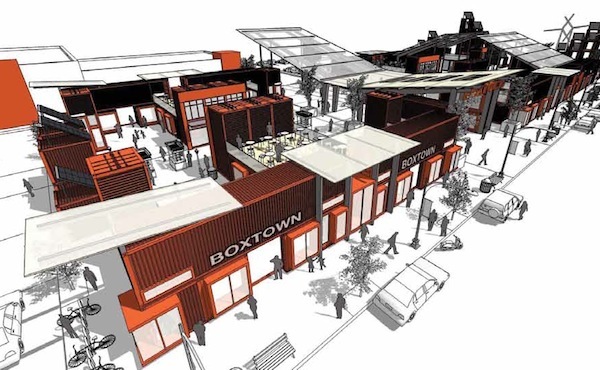Boxman Studios, the recognized leader in modified shipping containers, has launched a new division aimed at sustainable solutions for the Built Environment. The Boxman Studios Buildings Division will focus on the adaptive use of decommissioned shipping containers as architectural elements and even complete buildings.
The company hired veteran sales director Jim Curtis to manage its foray into the Built Environment sector. "Here at Boxman Studios we are fascinated with what we can do with shipping containers. In the right hands, these big metal boxes are extremely pliable," says Curtis. "With our success in the Events and Trade Show industries since 2008, we're perfectly positioned to move into the built environment with a narrative of unique design, modularity, flexibility, and value."
The launch of the new division comes on the heels of Boxman's recent move into a 65,000 square foot facility in North Charlotte. "Our new building means that all facets of an operation are under one roof. We can easily scale as needed," says Boxman Studios' CEO David Campbell. "Launching into container architecture for the Built Environment was a logical next step for our company."
"The Buildings Division will focus on the permanent and semi-permanent use of our creations. We envision modifying containers as structural and design elements in office buildings, retail stores, apartments, multi-family residential, public markets, pop-up restaurants, transit stations, even for emergency response purposes," Curtis added. "We're excited about the next phase in our company's growth."
About Boxman Studios
Founded in 2008, Boxman Studios offers design, development, and deployment services of customized shipping containers, modifying them for a range of markets and applications around the world.
Related Stories
| Mar 19, 2014
Is it time to start selecting your own clients?
Will 2014 be the year that design firms start selecting the clients they want rather than getting in line with competitors to respond to RFPs? That’s the question posed by a recent thought-provoking article.
| Mar 19, 2014
How to develop a healthcare capital project using a 'true north charter'
Because healthcare projects take years to implement, developing a true north charter is essential for keeping the entire team on track and moving in the right direction.
| Mar 18, 2014
6 keys to better healthcare design
Healthcare facility planning and design experts cite six factors that Building Teams need to keep in mind on their next healthcare project.
| Mar 18, 2014
How your AEC firm can win more healthcare projects
Cutthroat competition and the vagaries of the Affordable Healthcare Act are making capital planning a more daunting task than ever. Our experts provide inside advice on how AEC firms can secure more work from hospital systems.
| Mar 18, 2014
Charles Dalluge joins DLR Group as president, COO
CEO Griff Davenport announces addition of Dalluge to executive leadership team
| Mar 17, 2014
Rem Koolhaas explains China's plans for its 'ghost cities'
China's goal, according to Koolhaas, is to de-incentivize migration into already overcrowded cities.
| Mar 13, 2014
Do you really 'always turn right'?
The first visitor center we designed was the Ernest F. Coe Visitor Center for the Everglades National Park in 1993. I remember it well for a variety of reasons, not the least of which was the ongoing dialogue we had with our retail consultant. He insisted that the gift shop be located on the right as one exited the visitor center because people “always turn right.”
| Mar 13, 2014
Austria's tallest tower shimmers with striking 'folded façade' [slideshow]
The 58-story DC Tower 1 is the first of two high-rises designed by Dominique Perrault Architecture for Vienna's skyline.
| Mar 13, 2014
Simon Perkowitz to join KTGY Group
Perkowitz, the founder of Perkowitz + Ruth, will assist KTGY in responding to the demands and further development of its growing retail/commercial division.
| Mar 12, 2014
London grows up: 236 tall buildings to be added to skyline in coming decade, says think tank
The vast majority of high-rise projects in the works are residential towers, which could help tackle the city's housing crisis, according to a new report by New London Architecture.
















